本文目录
时间状语从句时态口诀初中
时间状语从句,望文生义,时间是最关键的。时间则根据时态的使用于表达,时态一错,整个语句的含意也错了,不一样的连词也需要配搭不一样的时态来使用。可以根据以下口诀进行区分:
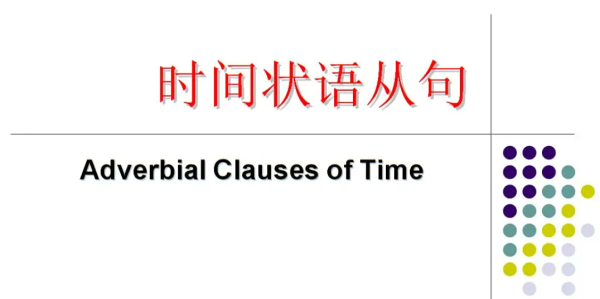
1、主从句时态照应,即主句用现在时,从句也用现在时;主句用过去式,从句也用在过去的某类时态,此外,主句用将来时,从句仍然得用现在时。如:When he was seven years old, he could swim.
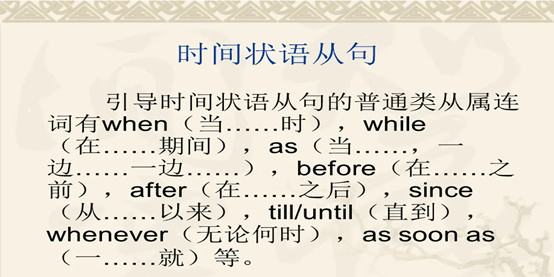
2、在时间状语从句中,不能用一般将来时、过去将来时态或将来完成时,而要用相应的一般现在时态、一般过去时或现在完成时来代替。如:I'll telephone you as soon as I get there。
宾语从句的用法归纳总结
这几个还真没有什么口诀!不过其他的如果有需要的话,可以发给你看!
反意疑问句用法
「速记口诀」
反意问句三要点,前后谓语正相反;
短句not如出现,必须缩写是习惯;
最后一点应注意,短句主语代词填.
「妙语诠释」①反意疑问句的构成应该是“肯定的陈述句+否定的疑问”或“否定的陈述句+肯定的疑问”;②在短句中not必须与do,will,can等组成缩写形式;③在简短问句中,疑问句的主语必须是代词,而不能用名词形式.
形容词和副词比较等级用法
「速记口诀」
1.比较级与最高级:两者比较than相连,三者比较the在前.
2.同级比较:同级比较用原形,as…as永不离;as…as加not,只言两者是同一,若是notso…as,后强前弱不看齐.
「妙语诠释」①比较级通常和than连用,而最高级通常跟有定冠词the;②同级比较一般用as…as表示“与…一样”,这时谁强谁弱不能比较出来,而notso…as则表示后者比前者强,翻译为“不如……”.
不定式作宾语补足语时省to的动词
「速记口诀」
一感,二听,三让,四看,半帮助
「妙语诠释」一感:feel;二听:hear,listento;三让:make,let,have;四看:see,notice,watch,ob-serve;半帮助:help.
接动名词作宾语的动词
「速记口诀」
Mrs.PBlackmissedabeefbag.(P.布莱克夫人丢了一个牛肉袋.)
「妙语诠释」该句话中每个字母代表了一个动词或短语,这些动词要求后面跟动名词作宾语.这些动词分别是:
M=mind,r=risk,s=succeedin,P=practice,B=bebusy,l=lookforwardto,a=admit,c=can‘thelp,k=keepon,m=miss,i=insiston,s=suggest,s=stop,e=enjoy,d=delay,
a=avoid,b=beworth,a=advise,g=giveup.
接不定式作宾语的动词
「速记口诀」
三个希望两答应,两个要求莫拒绝;
设法学会做决定,不要假装在选择.
「妙语诠释」
三个希望两答应:hope,wish,want,agree,promise
两个要求莫拒绝:demand,ask,refuse
设法学会做决定:manage,learn,decide
不要假装在选择:petend,choose
一、冠词基本用法
「速记口诀」
名词是秃子,常要戴帽子,
可数名词单,须用a或an,
辅音前用a,an在元音前,
若为特指时,则须用定冠,
复数不可数,泛指the不见,
碰到代词时,冠词均不现.
「妙语诠释」冠词是中考必考的语法知识之一,也是中考考查的主要对象.以上口诀包括的意思有:①名词在一般情况下不单用,常常要和冠词连用;②表示不确指的可数名词单数前要用不定冠词a或an,确指时要用定冠词the;③如复数名词表示泛指,名词前有this,these,my,some等时就不用冠词.
名词单数变复数规则
「速记口诀」
单数变复数,规则要记住,
一般加s,特殊有几处:
/s/结尾,es不离后,
末尾字母o,大多加s,
两人有两菜,es不离口,
词尾f、fe,s前有v和e;
没有规则词,必须单独记.
「妙语诠释」①大部分单数可数名词变为复数要加s,但如果单词以ch,sh,s,x等结尾,则一般加es;②以o结尾的单词除了两人(negro,hero)两菜(tomato,potato)加es外,其余一般加s;③以f或fe结尾的单词一般是把f,fe变为ve再加s;④英语中还有些单词没有规则,需要特殊记忆,如child—children,mouse—mice,deer—deer,sheep—sheep,Chinese—Chinese,ox—oxen,man—men,woman—women,foot—feet,tooth—teeth.
名词所有格用法
「速记口诀」
名词所有格,表物是“谁的”,
若为生命词,加“‘s”即可行,
词尾有s,仅把逗号择;
并列名词后,各自和共有,
前者分别加,后者最后加;
若为无生命词,of所有格,
前后须倒置,此是硬规则.
「妙语诠释」①有生命的名词所有格一般加s,但如果名词以s结尾,则只加“‘”;②并列名词所有格表示各自所有时,分别加“’s”,如果是共有,则只在最后名词加“‘s”;③如果是无生命的名词则用of表示所有格,这里需要注意它们的顺序与汉语不同,AofB要翻译为B的A.
感叹句用法
「速记口诀」
感叹句,并不难,what、how放句前;
强调名词用what,其余用how很简单.
「妙语诠释」由what引导的感叹句一般修饰名词,而how引导的感叹句一般修饰形容词、副词或句子.
宾语从句用法
「速记口诀」
宾语从句须注意,几点事项应牢记.
一是关键引导词,不同句子词相异.
陈述句子用that;一般疑问是否(if,whether)替;特殊问句更好办,引导还用疑问词.
二是时态常变化,主句不同从句异.主句若为现在时,从句时态应看意;主句若为过去时,从句时态向前移.
三是语序要记清,从句永保陈述序.
「妙语诠释」宾语从句应注意三点:①引导词,陈述句一般由that引导,这时的that可以省略;一般疑问句则由if或whe-ther引导;而特殊疑问句则由特殊疑问词引导.②时态,主句是现在时态,从句可用所需要的任何时态;但如果主句是过去时态,从句时态所表示时间一般往前移一个时间段.③语序,宾语从句永远要用陈述句顺序.
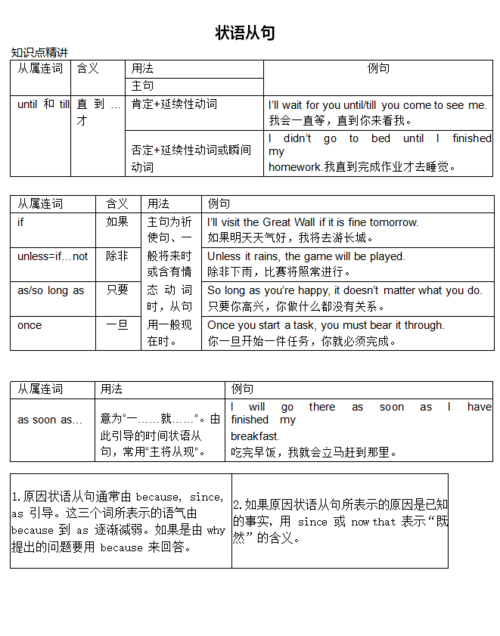
九大状语从句 请举例 并说明每句修饰的是什么词
状语从句是起着副词的作用的组词,用来修饰动词,副词和形容词。
状语从句可分为:
1.时间状语从句
(adverbial
clause
of
time)
例句:her
goldfish
died
when
she
was
young.(时间状语从句:when
she
was
young)
2.地点状语从句;(adverbial
clause
of
place)
例句:he
said
he
was
happy
where
he
was.
(地点状语从句:where
he
was)
3.原因状语从句;(adverbial
clause
of
reason)
例句:i
couldn't
feel
anger
against
him
because
i
liked
him
too
much.
(原因状语从句:because
i
liked
him
too
much)
4.条件状语从句;(adverbial
clause
of
condition)
例句:if
they
lose
weight
during
an
illness,
they
soon
regain
it
afterwards.
(条件状语从句:if
they
lose
weight
during
an
illness)
5.目的状语从句;(adverbial
clause
of
purpose)
例句:they
had
to
take
some
of
his
land
so
that
they
could
extend
the
chuchyard.
(目的状语从句:so
that
they
could
extend
the
chuchyard)
6.让步状语从句;(adverbial
clause
of
concession)
例句:i
used
to
read
a
lot
although
i
don't
get
much
time
for
books
now.
(让步状语从句:although
i
don't
get
much
time
for
books
now)
7.比较状语从句;(adverbial
clause
of
comparison)
例句:she
is
a
better
cook
than
i.
(比较状语从句:than
i)
8.结果状语从句;(adverbial
clause
of
results)
例句:my
suitcase
had
become
so
damaged
that
the
lid
would
not
stay
closed.
(结果状语从句:that
the
lid
would
not
stay
closed)
9.方式状语从句;(adverbial
clause
of
manner)
例句:
i
was
never
allowed
to
do
things
as
i
wanted
to
do
them.
(方式状语从句:
as
i
wanted
to
do
them)
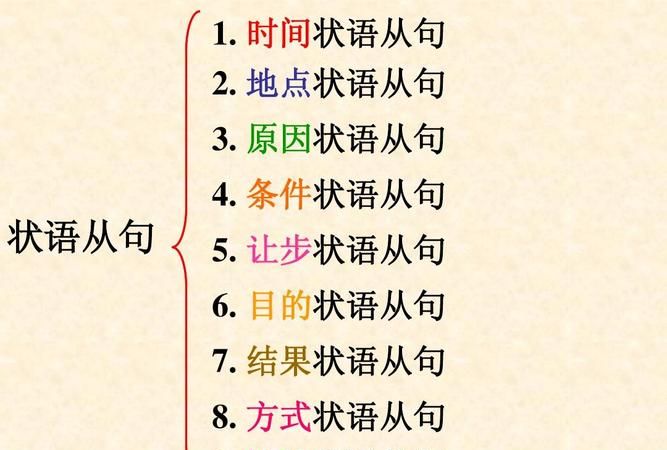
九大状语从句 请举例 并说明每句修饰的是什么词
状语从句是起着副词的作用的组词,用来修饰动词,副词和形容词。
状语从句可分为:
1.时间状语从句
(adverbial
clause
of
time)
例句:her
goldfish
died
when
she
was
young.(时间状语从句:when
she
was
young)
2.地点状语从句;(adverbial
clause
of
place)
例句:he
said
he
was
happy
where
he
was.
(地点状语从句:where
he
was)
3.原因状语从句;(adverbial
clause
of
reason)
例句:i
couldn't
feel
anger
against
him
because
i
liked
him
too
much.
(原因状语从句:because
i
liked
him
too
much)
4.条件状语从句;(adverbial
clause
of
condition)
例句:if
they
lose
weight
during
an
illness,
they
soon
regain
it
afterwards.
(条件状语从句:if
they
lose
weight
during
an
illness)
5.目的状语从句;(adverbial
clause
of
purpose)
例句:they
had
to
take
some
of
his
land
so
that
they
could
extend
the
chuchyard.
(目的状语从句:so
that
they
could
extend
the
chuchyard)
6.让步状语从句;(adverbial
clause
of
concession)
例句:i
used
to
read
a
lot
although
i
don't
get
much
time
for
books
now.
(让步状语从句:although
i
don't
get
much
time
for
books
now)
7.比较状语从句;(adverbial
clause
of
comparison)
例句:she
is
a
better
cook
than
i.
(比较状语从句:than
i)
8.结果状语从句;(adverbial
clause
of
results)
例句:my
suitcase
had
become
so
damaged
that
the
lid
would
not
stay
closed.
(结果状语从句:that
the
lid
would
not
stay
closed)
9.方式状语从句;(adverbial
clause
of
manner)
例句:
i
was
never
allowed
to
do
things
as
i
wanted
to
do
them.
(方式状语从句:
as
i
wanted
to
do
them)
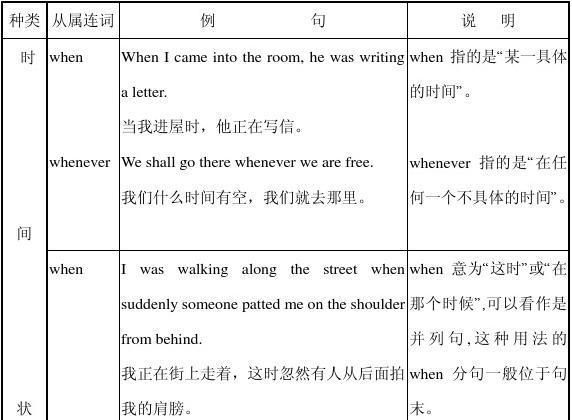
以上就是关于9大状语从句口诀 ,时间状语从句时态口诀初中的全部内容,以及9大状语从句口诀 的相关内容,希望能够帮到您。
